August 2005 // Volume 43 // Number 4 // Tools of the Trade // 4TOT5
Agriculture Environmental Management System Baseline Protocols
Abstract
The evaluation of agriculture environmental
programs and the subsequent acceptance by the agriculture industry will only
have credibility if they are based on the collection of comparable information
of known quality backed up by vigorous analysis and research. To this end,
Utah State University Extension Agriculture Environmental Management Systems
(AEMS) has adapted a common framework for collecting AEMS design and performance
information. The article is to describes this framework.
Introduction
University researchers and Extension specialist in 11 states are currently evaluating the impact of voluntary environmental management systems (EMS) for agricultural operations. This evaluation is being conducted through a series of studies with a wide variety of agriculture production operations that voluntarily choose to participate and share information on the design and implementation of their EMSs (Harrison, 2002; Partnership for Livestock Environmental Management Systems, 2004).
Background
The Utah State University Extension Agriculture Environmental Management Systems (AEMS) protocols were adapted from National Database on Environmental Management Systems (NDEMS) that were developed by the University of North Carolina (UNC) and the Environmental Law Institute (ELI) (2004). State regulatory managers, numerous facility managers, EPA offices, and several academic institutions reviewed them extensively. The remainder of this article describes the purpose and intended use of the data protocols and gives an overview of their content and structure.
Identification of operation's existing management systems begins when a producer logs into the USU Agriculture Environmental Management Information System (AEMIS) on the USU AEMS Web site (http://aems.aste.usu.edu) as a guest or cooperator (Harrison, Kanade, & Toney, 2004). Once into the system, the user can find all the capabilities associated with this very powerful tool meeting the needs. Figure 1 shows the user interface for AEMIS. The producer can then click on the link "Develop AEMS" on the menu that appears on the left hand side of the screen, which reveals a three-step process for developing an AEMS.
Figure 1.
AEMIS User Interface
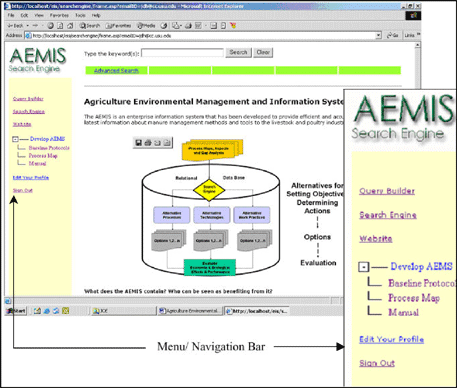
By clicking on the "Baseline Protocols," the producer begins his first step in eliciting a detailed description of the facility's baseline performance (Figure 2). The Demographics and Baseline Study pages are an electronic version of the National Database on Environmental Management Systems (Environmental Law Institute, 2000) adapted to the agriculture industry.
Cooperator Program Protocol I.0 and I.1 are one-time studies, and are implemented as soon as an operation decides to participate in the AEMS program (Figure 2). The purpose of Protocol I.0 is to describe some basic characteristics of the operation. After completing Protocol I.0, the operation should immediately complete I.1. The purpose of this Protocol I.1 is to describe in detail the information the operation is asked to submit as part of its participation in the AEMS program.
Figure 2.
Pilot Program Protocol I.0.
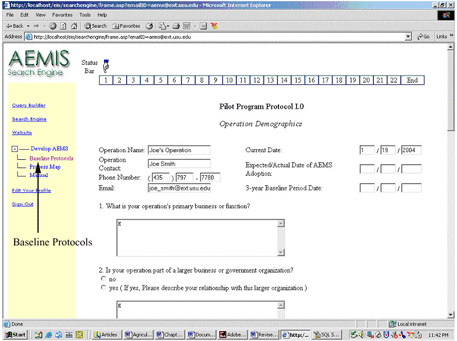
The questions in the protocols address the operation's existing management systems and its current and historical environmental and economic performance. Because the overall objective of the program is to assess how (if at all) the adoption of an agriculture environmental management system (AEMS) affects an operation's performance, it is critical to measure a pre-AEMS baseline from which changes in performance can be measured. Furthermore, recognition must be made of operations that have made substantial progress in implementing agriculture environmental management systems prior to joining the program, because it is likely that these operations will have already made environmental and economic performance advances in the past and thus may show less significant improvements after joining the program.
The Demographics Protocol contains only one part and will take a few minutes to complete. The Baseline Protocol is divided into the following six major sections:
- The Management Systems Baseline (Figure 3) covers the existing non-environmental and environmental management systems along with any voluntary participation involved in the environmental management programs.
- The Environmental Performance Baseline (Figure 4) identifies and briefly describes the indicators the producers are currently using to measure the environmental performance of their operation. These indicators may be measurable emissions or discharge data, compliance measures, numbers of spills or accidental releases, materials use, waste generation, time or money spent. These data are necessary to determine operation performance changes over time so that they are attributed to actual environmental performance changes rather than changes in production.
- The Compliance Baseline (Figure 5) questions the operation's compliance history over the past three years. A change in Regulatory Status refers to the operation's categorization under many environmental regulatory programs.
- On the other hand, the Pollution Prevention Baseline (Figure 6) focuses on industrial and organizational processes. Within these processes, waste production is minimized rather than curbed after its production. Pollution prevention does include materials substitution, process changes, and other activities that minimize waste production.
- The Interested Party Involvement Baseline (Figure 7) determines how an operation has included parties inside and outside the operation in environmental management decisions.
- Last, the Cost/Benefit Baseline (Figure 8) identifies and briefly describes the indicators you are currently using to measure the economic performance of your existing environmental management program. These indicators may include personnel costs, equipment costs, permit fees, operating costs, disposal costs, fines and penalties, etc.
- Each of these sections covers material that your operation will be asked to measure and submit on an ongoing basis.
Figure 3.
Management Systems Baseline
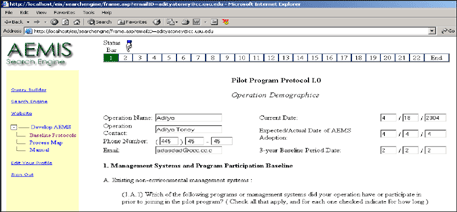
Figure 4.
Environmental Performance Baseline
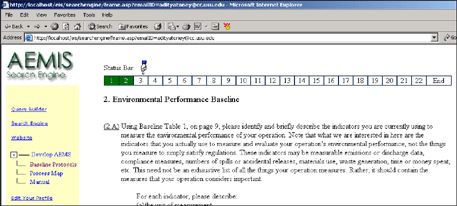
Figure 5.
Compliance Baseline
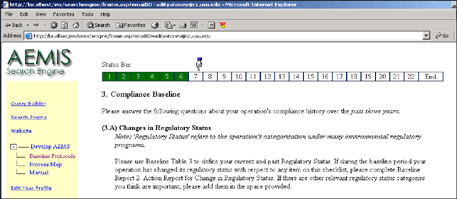
Figure 6.
Pollution Prevention Baseline

Figure 7.
Interested Party Involvement Baseline

Figure 8.
Cost/Benefit Baseline
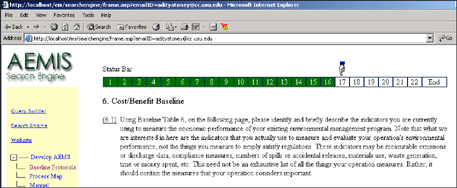
Summary
The operation and the AEMS staff select a program "start date" that will define the baseline period. The suggested start date is January 1, but an operation may choose a different start date if appropriate. To the best of the operator's abilities, baseline measurements should refer to the program start date, 1 year prior to the start date, and 2 years prior to the start date.
The objective in the baseline study is to understand how the operation has performed in each of these categories over the last 3 years. For user/producer convenience, each of the keywords used in the protocols is defined in a glossary found in a set of electronically linked Appendix.
The data called for in the protocols represent the kinds of information that facilities seeking to establish an EMS based on ISO 14001 would generally need to collect. As such, the protocols have been constructed so as to minimize any additional reporting burden that participating facilities might face. To assure completeness and true comparability of the data across facilities included in the database, it is important that participating facilities do their best to provide answers to all questions asked in the protocols and to participate in all six stages of the protocols. Only in this way can the AEMS program succeed in its effort to provide systematic and reliable information to facilities themselves and to the public on the impacts of EMS adoption.
References
Environmental Law Institute. (n.d.). National database on environmental management systems. Available at http://www.eli.org/
Harrison, J. D., Kanade, S. & Toney, A. (2004). Agriculture environmental management information system: An online decision support tool. Journal of Extension [On-line], 42(1). Available at: http://www.joe.org/joe/2004february/tt4.shtml
Harrison, J. D. (2002). Managing for sustainable agriculture. Journal of Extension [On-line], 40(4). Available at: http://www.joe.org/joe/2002august/a5.shtml
Partnership for Livestock Environmental Management Systems. (n.d.). Available at: http://www.uwex.edu/AgEMS/livestock/
